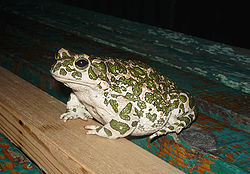Top Qs
Timeline
Chat
Perspective
European green toad
Species of amphibian From Wikipedia, the free encyclopedia
Remove ads
The European green toad (Bufotes viridis) is a species of true toad found in steppes, mountainous areas, semi-deserts, urban areas and other habitats in mainland Europe, ranging from far eastern France and Denmark to the Balkans, Western Russia and the Caucasus.[3] As historically defined, the species ranged east through the Middle East and Central Asia to western China, Mongolia and northwestern India, and south through Italy and the Mediterranean islands to North Africa.

Following genetic and morphological reviews, 14 populations (all largely or entirely Asian, except for the African and Balearic green toads) are now regarded as separate species. These species and the European green toad are placed in their own genus Bufotes, but they were included in Bufo.[4][5]
Remove ads
Description
This section includes a list of general references, but it lacks sufficient corresponding inline citations. (November 2015) |
The spots on the back vary from green to dark brown and sometimes red spots appear, too. The underside is white or very lightly coloured. The European green toad will change colour in response to heat and light changes. Females are larger than males and can lay 9,000 to 15,000 eggs at a time.

It can reach a maximum size (head and body length) of 10 centimetres (3.9 in), but growth to this size is rare.[6]
Remove ads
Behavior
This species of toad is mainly nocturnal, although diurnal behaviors are sometimes recorded during parts of the year, especially in spring.[7] It loves warm summers with high water temperatures and in order to avoid the cold weather it hibernates during the winter. Its lifespan is 8-9 years in captivity and up to 7 years in the wild.[8]
Diet
Bufotes viridis eats a variety of insects and invertebrates, mainly crickets, meal worms, small butterflies, earthworms, moths, beetles, ants, spiders[9] and caterpillars. There has also been a reported attack on a bat.[10]
Defense mechanism
The European green toad has the ability to secrete defensive toxins from its parotid glands and these toxins are effective enough to kill most of the toad's predators. They are harmless to humans when contact is made with the skin.[7]
Remove ads
References
Further reading
External links
Wikiwand - on
Seamless Wikipedia browsing. On steroids.
Remove ads



